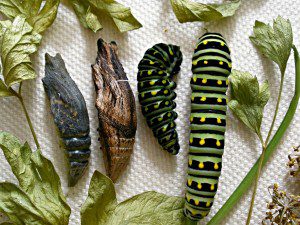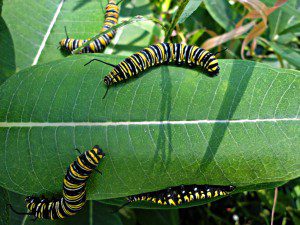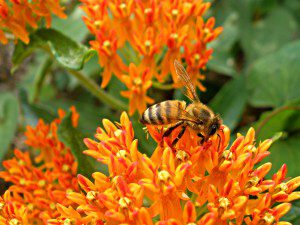By Ansel Oommen
Guest Writer for Wake Up World
Insects and other invertebrates account for over 90% of all living species, building the basis for most ecosystems. In fact, they often dominate their landscapes through both sheer number and volume, providing many key services, either directly or obliquely, as pollinators, recyclers, pest control and as food for a host of animals.
Due to the effects of dramatic changes in climate, habitat loss, and pesticides, insect populations are declining worldwide. Honeybees, for example, have attracted media attention since 2006, with their death tolls linked to neonicotinoids and a lack of supportive flora. The monarch butterfly, whose population once reached 900 million in 1995, now sits precariously at a meager 56.5 million- a 95% drop, placing it within risk of extinction.
Keeping this in mind, the role of the urban gardener is now more important than ever before.
Underlying the struggle of invertebrate conservation is a pervasive negative image. Mislabeled as “creepy crawlies”, many bugs, even beneficial ones, can elicit common phobias, further hindering public support and activism.
However, as biologist E.O. Wilson summarized:
“If we were to wipe out insects alone, just that group alone from this planet, which we are trying hard to do, the rest of life and humanity with it would most likely disappear from the land- and within a few months.”
So while they are not the top priority in the urban environment, we must reconsider these multi-legged critters as allies in our future narrative. Because insects have multiple life stages with shifting needs, gardens are best developed with seasonal and generational changes in mind. Many species including wasps, beetles, flies, and moths, for instance, are marked by a semi-mobile larval stage, an immobile pupal stage, and a highly mobile adult stage, requiring an understanding of their habitat preferences.
Central to the success of insect conservation, however, is an equal emphasis on floral biodiversity. Simply put, each party cannot be evaluated without the other. Plants form complex structural communities, so much so, that the presence or lack thereof of certain vegetation can influence the presence of a target species, which in turn, can affect the overall health of urban spaces.
This is especially true with pollinators. In North America, native bees work hard during the spring and summer seasons visiting flowers. In fact, they pollinate two to three times more efficiently than the introduced honeybee via buzz pollination, especially with crops like tomatoes, squash, and blueberries. Their labor rewards both humans and animals with fresh fruits, vegetables and seeds. Without their efforts, other wildlife would face starvation in the colder months.
 Caterpillars of many Lepidopteran species rely on specific host plants. For example, the blue lupine (Lupinus perennis) is the sole host of the federally-endangered Karner blue butterfly while the monarch depends entirely on milkweed (Asclepias spp.).
Caterpillars of many Lepidopteran species rely on specific host plants. For example, the blue lupine (Lupinus perennis) is the sole host of the federally-endangered Karner blue butterfly while the monarch depends entirely on milkweed (Asclepias spp.).
As a result, butterflies and moths are key biomarkers of local diversity. A decrease in their abundance and variety can signify a degenerative landscape dominated by exotic plants. Conversely, a native themed landscape is more likely to attract rarer species. In addition, caterpillars serve as a major food source for songbirds, who time their reproduction on larval emergence. Thus, insect conservation goes hand in hand with the conservation of more popular birds, mammals, reptiles, and amphibians.
Gardeners are in a unique position to address this issue of habitat loss through careful ecologic design and stewardship. As with business, local support is directly beneficial. Selecting native plants for urban design creates buffering green habitats in otherwise inhospitable sites. By simply being more conscious of native species, gardeners can add a layer of sustainability, without sacrificing aesthetics.
Oftentimes, non-native plants are used, sometimes to ill effect. Unlike their native counterparts, exotic plants lack the natural pests and diseases that keep them in check and when coupled with vigorous growth and reproduction, can quickly become an issue. While most introduced plants pose little threat, some get out of control, undermining the structural integrity of the garden landscape and surrounding areas. In the process, they displace native communities, alter food chains, reduce aesthetic appeal, and create significant economic and environmental costs.
The autumn olive (Elaeagnus umbellata), Tartarian honeysuckle (Lonicera tatarica), and multiflora rose (Rosa multiflora) were all once planted in the U.S. with good intentions. They are now listed as noxious weeds in several states. Providing seasonal interest in the form of flowers and fruits, these shrubs were originally used for erosion control, cover, and food for wildlife. In hindsight, native alternatives such as Maple-leaf viburnum (Viburnum acerifolium), coral honeysuckle (Lonicera sempervirens), and climbing prairie rose (Rosa setigera) would have been more suitable.
 Indeed, it is important to note that weeds can be native or non-native, invasive or non-invasive, or noxious, if designated by a form of government as harmful to the landscape.
Indeed, it is important to note that weeds can be native or non-native, invasive or non-invasive, or noxious, if designated by a form of government as harmful to the landscape.
However, in certain cases, weeds can be beneficial. Dandelions and clovers add an element of life to the green desert that is the manicured lawn, and yet, the internet is full of articles on how to kill them.
At the root of this injustice is a lack of awareness. Our perceptions of what we deem as acceptable built environments can be based on misguided values, which then inform our actions. But it is important to think about the grand scheme of things in the long term beyond us. Dandelions are a magnet for bees, flies, beetles, and butterflies. Widespread and hardy, they are reliable bloomers during the early parts of spring, when other nectar sources are scarce and when pollinators are most vulnerable. Clovers were originally added to lawn mixes to fortify grasses through nitrogen fixation and for evergreen, drought tolerant cover. By razing them or using herbicides in spring, an entire microhabitat is destroyed, endangering the future of the local denizens. Multiply this by the neighborhood and city levels and the effects become more apparent.
Somewhere along the way, public acceptance has grown for sterile landscapes. But thankfully, it is equally possible to shift that demand for green spaces to landscapes that sustain life — to those areas that brim with the hum of bees, the chitter of songbirds and the cooling splashes of verdure alongside networks of houses, cars, and people– a place that is equally for them as it is for us.
As a result, urban gardeners are the first line of defense against a lifeless future. There is pride to be had, beauty to be felt, and a true sense of accomplishment to be shared in being part of a mindful landscape. Change is slow but time is not. We have a direct stake in this matter.
The time to act is now.
Further reading:
- All-Natural Pesticide Unveiled by Scientists – and It Won’t Kill the Bees!
- Permaculture – What Is It and Why Is It Important?
- How Monsanto’s ‘RoundUp’ is Cursing the Global Food Supply
- Neil Young, Pope Francis and 100,000 Beekeepers Take a Stand Against Toxic Agriculture
- Scientists Link Mass Death of Honey Bees to Farm Insecticide
References:
- Hunter, M., & Hunter, M. (2008). Designing for conservation of insects in the built environment. Insect Conservation and Diversity, 1, 189-196.
- Fickenscher, J., Litvaitis, J., Lee, T., & Johnson, P. (2014). Insect responses to invasive shrubs: Implications to managing thicket habitats in the northeastern United States. Forest Ecology and Management, 322, 127-135.
- Gashler, K. (n.d.). Native bees are better pollinators, more plentiful than honeybees, finds entomologist | Cornell Chronicle. Retrieved May 19, 2015. http://news.cornell.edu/stories/2011/10/native-bees-are-better-pollinators-honeybees
- Moisset, B., & Buchmann, S. (n.d.). Bee Basics: An Introduction to Our Native Bees. Retrieved May 19, 2015. http://www.fs.usda.gov/Internet/FSE_DOCUMENTS/stelprdb5306468.pdf
- CES – Pollination Tool Kit: Pollinators in Decline. (n.d.). Retrieved May 19, 2015. http://www.esa.org/ecoservices/poll/body.poll.scie.decl.html
- Monarch Numbers Up Slightly, But Butterfly Still at Risk of Extinction. (n.d.). Retrieved May 19, 2015. http://www.biologicaldiversity.org/news/press_releases/2015/monarch-butterfly-01-27-2015.html
- Invasive Plants. (n.d.). Retrieved May 19, 2015. https://www.dot.ny.gov/divisions/engineering/design/landscape/trees/invasive-species
- American Society of Naturalists. (n.d.). Retrieved May 19, 2015. http://www.amnat.org/an/newpapers/JulyHinks.html
- Landscapes at Risk from Invasive Species. (n.d.). Retrieved May 19, 2015. http://dnr.wi.gov/topic/invasives/documents/designers.pdf
Previous article by Ansel Oommen:
About the author:
Ansel Oommen is a garden writer, citizen scientist, and medical transcriptionist whose works have been published in magazines such as Atlas Obscura, Well Being Journal, and Entomology Today, among others. Discover more at www.behance.net/Ansel.
Photography © Ansel Oommen.

If you've found value in our articles, we invite you to support the release of our brand-new book, "Gratitude Practices for Kids: A Practical Guide for Adults to Instill a Spirit of Appreciation and Positivity in the Next Generation."
"Gratitude Practices for Kids" brings together over 25 innovative and accessible practices designed to enhance gratitude in everyday life. This comprehensive guide is backed by 17 scientific studies, ensuring each concept is grounded in research, underscoring our commitment to nurturing growth, emotional intelligence, and positive interactions between adults and children.
We encourage you to opt for the paperback version to celebrate this new release. Dive into its fresh pages away from digital distractions, allowing you to immerse yourself in the transformative practices it offers.
Over recent years, Wake Up World has faced significant online censorship, which has impacted our financial ability to operate. Moving into book publishing represents a strategic step to secure the ongoing funds needed to continue our mission. By purchasing Gratitude for Kids, you help us keep our content free and accessible to everyone, avoiding needing a paywall. With over 8,500 articles published in the last 13 years, we remain dedicated to keeping our valuable content open to all.








